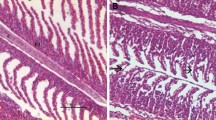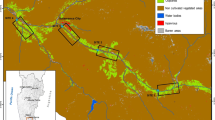Abstract
The 70-kDa stress protein family (HSP70) plays important roles in a variety of physiological processes, including protein chaperoning, protection against apoptosis, steroidogenesis, and general cellular stress responses in vertebrate organisms, and has also been proposed as a biochemical marker of environmental stress, such as toxicant exposure. The objectives of this study were to determine HSP70 protein expression in head kidney, liver, gill, and ovarian tissues and to examine reproductive physiological responses in female fishes exposed chronically to sublethal metal concentrations. Female black bullhead (Ameiurus melas) and bluegill sunfish (Lepomis macrochirus) were collected from Tar Creek, Oklahoma (flowing through the Tri-State mining district) and from a nearby reference creek (Lytle Creek) during spring (prespawning; 26.5 ± 0.95°C water temperature) and winter (ovarian recrudescence; 4.8 ± 0.80°C water temperature). Aqueous (dissolved and suspended) concentrations of Cd and Zn and liver concentrations of Cd and Zn in both fish species were significantly greater at Tar Creek compared to Lytle Creek. HSP70 expression was consistently elevated in the head kidney of both fish species collected at Tar Creek in comparison to fish collected from the reference creek. In contrast, no consistent differences were observed in HSP70 expression in liver, gill, or ovarian tissues between sites. Significant seasonal differences were observed in expression of HSP70 in gill tissue of both species, in ovarian and liver tissue of bluegill sunfish and in head kidney of black bullhead. Serum testosterone concentration was significantly reduced in sunfish collected from Tar Creek during winter. Gonadosomatic and hepatosomatic indices were significantly lower in black bullhead collected from Tar Creek during spring, and condition factors were lower in black bullhead collected from Tar Creek during both spring and winter. There was no significant difference in the extent of ovarian follicular cell apoptosis in either species collected during spring. In conclusion, we observed significant tissue specific differences and seasonal variation in expression of HSP70, as well as alterations in circulating testosterone levels in female fish chronically exposed to metals.
Similar content being viewed by others
Author information
Authors and Affiliations
Additional information
Received: 12 May 2002/Accepted: 26 January 2003
Rights and permissions
About this article
Cite this article
Yoo, J., Janz, D. Tissue-Specific HSP70 Levels and Reproductive Physiological Responses in Fishes Inhabiting a Metal-Contaminated Creek. Arch. Environ. Contam. Toxicol. 45, 0110–0120 (2003). https://doi.org/10.1007/s00244-002-0109-7
Issue Date:
DOI: https://doi.org/10.1007/s00244-002-0109-7




